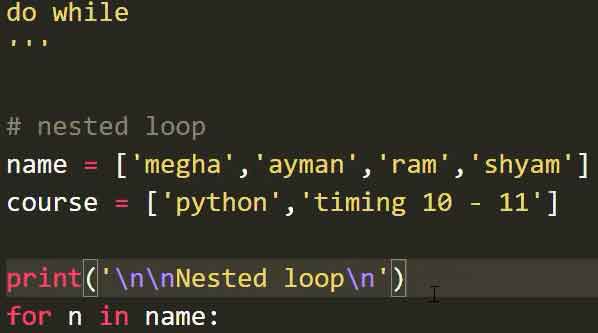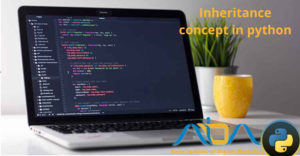Post Contents
Types of loops in python
There are three loops in python which are commonly used as a python developer.
- for loop in python 3
- do-while loop in python
- if loop in python
For loop in python
With regards to most information science work, Python for loop range is utilized to loop through an iterable item (like top-notch, tuple, set, and so on.) and perform a similar activity for each section. For instance, a for loop would permit us to iterate through top-notch, performing a similar activity on each thing in the list.
(A for loop, incidentally, is any Python object we can iterate through, or “loop” through, and return a solitary component at a time. Lists, for instance, are iterable and return a solitary list section at a time, in the request, passages are listed. Strings are iterable and return each character in turn, as per the pattern in which the characters appear. And so on.)
You can search on Google the phrase like python classes near me, and you will us on the tops because of our authentic and industries’ best python training in Delhi
You make a for a loop by first characterizing the iterable article you’d prefer to loop through, and then characterizing the activities you’d prefer to perform on each thing in that iterable item. For instance, while repeating through top-notch, you first specify the list you’d prefer to iterate through and then specify what activity you’d prefer to perform on each listed thing.
We should take a gander at a speedy model: in the event that we had a list of names put away in Python, we could utilize a for loop to iterate through that list, printing each name until it reached the end. Beneath, we’ll make our list of names, and then compose a for loop that iterates through it, printing each passage on the list in succession. Below we have shown the for loop in python with example.
It will be good if you learn Data Science course in delhi yourself by joining the Django training in delhi

our_list = [‘Lily’, ‘Brad’, ‘Fatima’, ‘Zining’]
for the name in our_list:
print(name)
Lily
Brad
Fatima
Zining
This code in this straightforward loop brings up an issue, however: where did the variable name originate from? We haven’t characterized it beforehand in our code! But since for loops in python 3 iterates through lists, tuples, and so forth in the grouping, this variable can really be called nearly anything.
This code in this straightforward loop brings up an issue, however: where did the variable name originate from? We haven’t characterized it beforehand in our code! But since for loops iterate through lists, tuples, and so forth in the grouping, this variable can really be called nearly anything.
Do-while loop in python
There are two scenarios in which a loop ends:
The loop condition is not, at this point valid/bogus (contingent upon the sort of loop).
A break statement is executed from inside the code insider savvy body.
Examine the code, for printing the initial 3 integers, below:
I = 1
while True:
print(i)
I = I + 1
if(i > 3):
break
The do-while loop in C++ and the emulation of a do-while loop in Python bring about a similar yield. In the Python emulation, “I” is being printed before the condition is checked, only like in the do-while loop in C++.
If loop in python

If loop in python are controlled stream statements which cause us to run a particular code just when a specific condition is satisfied. For instance, you need to print a message on the screen just when a condition is genuine then you can utilize if statement to accomplish this in programming. In this guide, we will figure out how to utilize If loop in python programming with the assistance of models.
The syntax of If loop in python is pretty simple.
if condition:
block_of_code
Python – If Statement Example
banner = True
if flag==True:
print(“Welcome”)
print(“To”)
print(“AIDM”)
Yield:
Welcome
To
AIDM
Python for-loop increment
Python for-loop increment, when all is said in done, are utilized for successive crossing. It falls under the class of distinct emphasis. Unmistakable emphases mean the number of redundancies is specified unequivocally ahead of time. In any case, have you ever pondered, what occurs, if you try Python for-loop increment the value of the iterator from inside the for loop? How about we see with the assistance of the underneath model.

Model:
filter_none
alter
play_arrow
brightness_4
lis = [1, 2, 3, 4, 5]
for I in range(len(lis)):
print(lis[i])
I += 2
Yield:
1
2
3
4
5
Python for loop model utilizing range() work
Here we are utilizing range() capacity to calculate and display the aggregate of first 5 natural numbers.
# Program to print the entirety of the first 5 natural numbers
# variable to store the entirety
entirety = 0
# repeating over natural numbers utilizing range()
for val in range(1, 6):
# ascertaining whole
entirety = whole + val
# displaying the entirety of the first 5 natural numbers
print(sum)
Yield:
15
For loop with else block
Unlike Java, In Python, we can have a discretionary ‘else’ block related to the loop. The ‘else’ block executes just when the loop has finished all the cycles. Let’s take a model:
for val in range(5):
print(val)
else:
print(“The loop has finished execution”)
Yield:
0
1
2
3
4
The loop has finished execution
Join our online & offline PHP training in Delhi and Artificial Intelligence course in Delhi to become an expert in this field.
Nested For loop in Python
At the point when a for loop is available inside another for loop then it is known as a nested for loop. Let’s take a case of nested for loop.
for num1 in range(3):
for num2 in range(10, 14):
print(num1, “,”, num2)

Yield:
0 , 10
0 , 11
0 , 12
0 , 13
1 , 10
1 , 11
1 , 12
1 , 13
2 , 10
2 , 11
2 , 12
2 , 13 So this is all about the “for” loop in python programing language which is well presented by our trainer at AIDM, which provides the best python training in Delhi and creates tons of python developer to serve the python industry.
Recommended Artical:

- Number system, random module, math library, decimal in the python programming language
- Variable and datatypes work and behaviours in python language
- Python setup and a basic understanding of python language
- How to use casting and string in python
- Use of Boolean Datatype and Python Operators
- Use case of the tuple in python difference between list and tuplePython Sets And Dictionaries Python Lists, Python Sets & Dictionary







